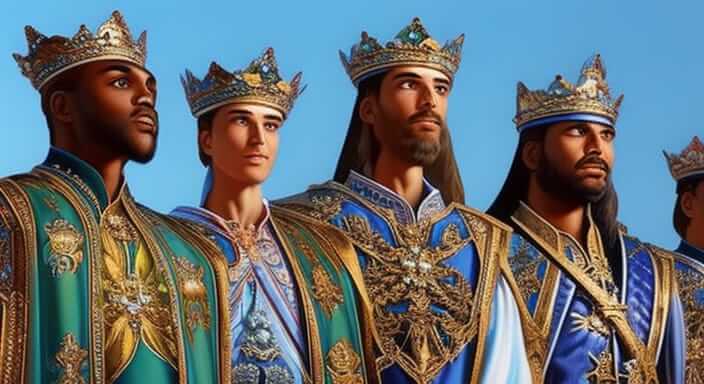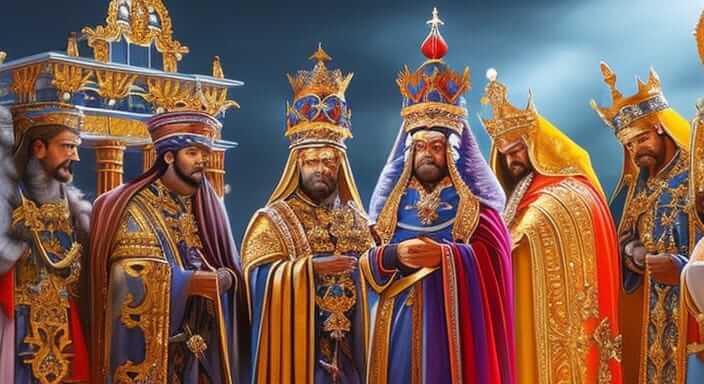Discover the rich symbolism behind the Feast of the Three Kings, also known as Epiphany. Learn about the origins, cultural traditions, and the significance of this celebration in different parts of the world.

Epiphany is a Christian feast day that commemorates the manifestation of Jesus Christ to the world. It is often associated with the visit of the Magi (Three Wise Men or Three Kings) to the infant Jesus in Bethlehem, as recounted in the Gospel of Matthew. The term “epiphany” itself comes from the Greek word “epiphaneia,” which means “manifestation” or “appearance.”
The primary focus of Epiphany is the revelation of Jesus as the Savior and the recognition of his divinity by the Magi, who were non-Jewish individuals representing the Gentile nations. Their visit is seen as a symbol of Christ’s manifestation to all people, not just to the Jewish community. The story emphasizes the inclusive nature of Jesus’ mission and the universal message of salvation.
Epiphany is celebrated on January 6th in Western Christianity. In some traditions, it also commemorates other events like the Baptism of Jesus in the Jordan River and his first miracle at the wedding in Cana. In many cultures, Epiphany is associated with various customs, including the blessing of homes, the exchange of gifts, and the consumption of special foods like “King’s Cake” in some places.
When is the Feast of the Three Kings celebrated, and what significance does it hold in the religious calendar?
The Feast of the Three Kings, also known as the Feast of Epiphany or simply Epiphany, is celebrated on January 6th. It holds significant importance in the religious calendar of Christianity as it commemorates the manifestation of Jesus Christ to the world, particularly through the visit of the Magi (Three Wise Men or Three Kings) to the infant Jesus in Bethlehem.
The significance of the Feast of the Three Kings lies in its portrayal of Jesus as the Savior not only for the Jewish people but also for all nations. The story of the Magi’s journey to Bethlehem emphasizes the universality of Christ’s message of salvation and the inclusion of Gentiles (non-Jewish individuals) in the divine plan. The Magi, who were astrologers from the East, recognized the significance of the star that appeared in the sky as a sign of the birth of a special king. Their journey to pay homage to Jesus, even from distant lands, highlights the idea that Jesus came to bring salvation to all people, regardless of their background.
In many Christian traditions, the Feast of the Three Kings marks the conclusion of the Christmas season. It is a time of celebration and worship, often involving special church services, prayers, and customs. In some cultures, it is customary to bless homes and exchange gifts on this day. The feast also reminds believers of the importance of seeking Christ and his message in their lives and of sharing that message with others, just as the Magi shared their knowledge of the Savior’s birth.
What are the origins of Epiphany, and which traditions does it trace back to?
The origins of Epiphany trace back to the early Christian traditions and the merging of various cultural and religious influences. The concept of “epiphany,” meaning a manifestation or revelation, has roots in both Jewish and Greek traditions, which were incorporated into the early Christian understanding of the event.
- Jewish Roots: The idea of a divine manifestation or revelation has its basis in Jewish thought. In the Old Testament, there are instances of God revealing himself to individuals or groups, such as the burning bush to Moses or the pillar of fire and cloud leading the Israelites in the wilderness. The concept of divine manifestations was carried over into early Christian theology.
- Eastern Christian Traditions: In the Eastern Christian tradition, particularly the Greek-speaking churches, Epiphany is known as “Theophany,” which means “manifestation of God.” This emphasizes the revelation of the Holy Trinity at the Baptism of Jesus in the Jordan River. The Gospel accounts of the Baptism emphasize the descent of the Holy Spirit in the form of a dove and the voice of God the Father declaring Jesus as his beloved Son. This event is seen as a key moment of divine manifestation and the revelation of Jesus’ identity and mission.
- Magi and Gentile Inclusion: The Gospel of Matthew, which records the visit of the Magi to the infant Jesus, highlights the importance of Jesus’ manifestation to the Gentile nations. The story symbolizes the inclusion of all people in God’s plan of salvation, and it reinforces the idea that Jesus came for the entire world, not just the Jewish community.
- Cultural Influences: The date of January 6th for Epiphany was likely influenced by the Jewish festival of Hanukkah, which falls around the same time and commemorates the rededication of the Second Temple in Jerusalem. As Christianity spread, some pagan festivals and customs around the beginning of the year were incorporated into the celebration of Epiphany as well.
Over time, these various influences converged, and Epiphany became a significant feast day in the Christian calendar, celebrated to commemorate the manifestation of Jesus Christ to the world. Different Christian traditions emphasize different aspects of the event, such as the visit of the Magi, the Baptism of Jesus, and the revelation of the Holy Trinity. Despite variations in interpretation and emphasis, the central theme of Epiphany remains the manifestation of Jesus as the Savior and the inclusion of all people in God’s plan of salvation.
How is the Feast of the Three Kings celebrated in different cultures, and what rituals are involved in these celebrations?
The Feast of the Three Kings, also known as Epiphany, is celebrated in various cultures around the world, and each culture has its own unique traditions and rituals associated with the holiday. Here are some examples of how this feast is celebrated in different cultures:
- Spain and Latin America: In many Spanish-speaking countries, Epiphany is known as “Dia de los Reyes” (Day of the Kings) or “Dia de Reyes” (Kings’ Day). It is a major holiday, and the night before, children often leave their shoes out for the Three Kings to fill with gifts, similar to the tradition of leaving stockings out for Santa Claus. Parades and processions featuring the Three Kings are common, and people often enjoy a special sweet bread called “Rosca de Reyes,” which contains a hidden figurine representing the baby Jesus and a dried bean. Whoever finds the figurine is responsible for hosting a party on Candlemas (February 2nd).
- France: In France, Epiphany is celebrated with a special pastry called “Galette des Rois” (Kings’ Cake). This is a round cake made of puff pastry, with a hidden figurine or a small charm inside. The person who finds the hidden item in their slice of cake is crowned “king” or “queen” for the day and often wears a paper crown.
- Germany: In Germany, Epiphany is known as “Three Kings’ Day.” Children go caroling from house to house, collecting donations for charity. The custom of “star singing” involves children dressed as the Three Wise Men carrying a star and singing songs to bless homes.
- Italy: In Italy, Epiphany is a national holiday, and the tradition of “La Befana” is prominent. La Befana is a mythical old woman who is said to bring gifts to children on the night of January 5th. Children leave stockings out for La Befana to fill with sweets and small presents.
- Greece: In Greek Orthodox tradition, Epiphany is known as “Theophany.” A major ritual involves the “Blessing of the Waters,” where a cross is thrown into a body of water, symbolizing the Baptism of Jesus. Young men may also dive into the cold water to retrieve the cross, and it’s believed that the one who retrieves it will have good luck throughout the year.
- Ethiopia: In the Ethiopian Orthodox Church, Epiphany is a grand celebration known as “Timket.” It involves a colorful procession, prayers, and the blessing of water. Participants often wear traditional clothing and carry crosses, and there are reenactments of Jesus’ baptism in water blessed for the occasion.
These are just a few examples, and there are many more unique customs and traditions associated with the Feast of the Three Kings in various cultures around the world. Despite the differences, the central theme of celebrating the manifestation of Jesus Christ and the universal message of salvation remains consistent across these diverse celebrations.

What is the symbolism behind the Feast of the Three Kings, and why are they referred to as the “Three Kings”?
The Feast of the Three Kings, also known as Epiphany, carries rich symbolism that reflects the deeper theological meanings associated with the event. The symbolism is rooted in the biblical account of the Magi’s visit to the infant Jesus. Here are some key aspects of the symbolism behind the feast:
- Universal Salvation: The visit of the Three Kings, or Wise Men, represents the universal message of Jesus’ birth and mission. The Magi came from distant lands, likely representing different cultures and backgrounds, to pay homage to Jesus. This emphasizes that Jesus is the Savior not only for the Jewish people but for all nations and people around the world. The feast highlights the inclusivity of Christ’s message and the idea that his salvation is accessible to everyone.
- Recognition of Divinity: The gifts brought by the Magi—gold, frankincense, and myrrh—symbolize the recognition of Jesus’ divinity, kingship, and sacrificial mission. Gold is associated with kingship and wealth, frankincense is used in religious rituals as a symbol of divinity, and myrrh was often used in burial preparations, foreshadowing Jesus’ sacrificial death.
- Guided by Signs: The star that led the Magi to Jesus is a symbol of guidance and revelation. It signifies divine communication and intervention, guiding them to the significant event of Jesus’ birth. This highlights the theme of divine guidance in recognizing and finding Jesus in our lives.
- Humility and Majesty: The juxtaposition of the humble surroundings of Jesus’ birth with the royal status of the Magi emphasizes the themes of humility and majesty. Jesus, born in a stable, demonstrates his humility and identification with humanity. The Magi, on the other hand, represent earthly majesty and wealth. The meeting of these two worlds underscores the profound nature of Christ’s mission.
- Seeking and Worship: The journey of the Magi to find and worship the newborn King is symbolic of the human quest for meaning, truth, and a higher purpose. Their dedication to seeking the divine and offering worship illustrates the response of faith that is required to encounter Jesus in our lives.
As for the term “Three Kings,” it is a common way to refer to the Magi who visited Jesus in the nativity story. However, the Gospel of Matthew does not specifically mention their number or identify them as kings. The identification of three kings likely comes from the number of gifts they brought, as well as the early Christian tradition that developed around their visit. The term “Three Kings” has become a widely recognized way to refer to them in popular culture and religious discussions, despite the biblical text not specifying their exact number or regal status.